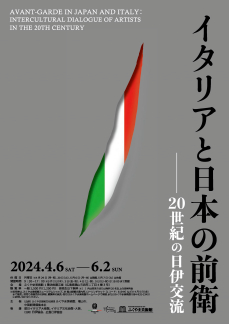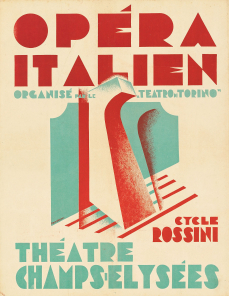One of the works in the TAKEO Poster Collection, Enrico Prampolini's "Théatre Champs Elysées, Opéra Italien" (1929) is being shown at the exhibition "Avant-garde in Japan and Italy: Intercultural Dialogue of Artists in the 20th Century" at the Fukuyama Museum of Art in Fukuyama City, Hiroshima Prefecture.
Special exhibition: "Avant-garde in Japan and Italy: Intercultural Dialogue of Artists in the 20th Century"
|
Dates: |
April 6 – June 2, 2024 |
|
|
(Closed Mondays and May 7, but open April 29 and May 6) |
|
Venue: |
First-floor gallery, Fukuyama Museum of Art |
|
|
2-4-3 Nishimachi, Fukuyama-shi, Hiroshima Prefecture (Map) |
|
Admission: |
General: 1,500 yen; High school students and younger: free |
|
Organizers: |
Fukuyama Museum of Art, Fukuyama Arts Foundation; Fukuyama City; |
|
|
Bingo Headquarters of Chugoku Shimbun |
The following is an excerpt from the exhibition website for "Avant-garde in Japan and Italy: Intercultural Dialogue of Artists in the 20th Century."
Tracing its origins back to the Meiji Period, when Italian artists came to Japan to teach at art schools, artistic exchange between Italy and Japan has continued for over 150 years. This exhibition focuses on the twentieth century, when artists moved towards achieving an equal exchange, abandoning the previous framework in which Western artists taught Japanese artists, and traces the origins of Italian artworks that remain in Japan today.
How did the twentieth-century Italian artworks held in Japan today come to Japan? And, how did the Japanese people view the works when they were brought to their country? Posing these kinds of questions from the vantagepoint of the twenty-first century provides an idea of the situation in Italy and Japan at that time.
Through about one hundred pieces of art and other materials, the show takes a fresh look at Italian art that remains in Japan today, and reveals the wide network of human relationships that developed, beginning with the exchange between Italian Futurists and Seiji Togo and Kambara Tai, and the friendship between leading postwar Italian artist Lucio Fontana and prominent postwar Japanese poet and art critic Shuzo Takiguchi.


